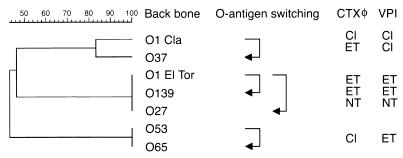FIG. 6.
Model for emergence of the non-O1 and non-O139 strains with epidemic potential by O-antigen switching. A dendrogram of the genetic relatedness of the various serogroups, based on IS1004 fingerprinting analysis, is shown on the left. The O37 strain appears to have been derived from an O1 preclassical strain (classical VPI cluster) by O-antigen shifting, divergence, and subsequent acquisition of an El Tor CTXφ. The El Tor strains diverged from classical strains, acquired a distinct CTXφ, and probably acquired a tcpA allele by recombination (30). The O139 strain appears to have been derived from an El Tor strain by O-antigen switching, and the O27 strain appears to have been derived from an El Tor progenitor and to have acquired a distinct CTXφ and a distinct VPI. It is also probable that O27 emerged from an El Tor strain by O-antigen switching and subsequently changed its rstR and tcpA genes by allelic exchange. The O53 and O65 strains have an El Tor VPI cluster and are identical to each other. They have genetic backbones resembling those of both classical and El Tor strains, and hence, they probably emerged from an O1 progenitor, diverged, and subsequently acquired a classical pre-CTXφ and and an El Tor VPI. These two strains probably underwent O-antigen switching events independently or sequentially, from O1 to O53 and O65. Cl, classical; ET, El Tor; NT, novel type (38).

